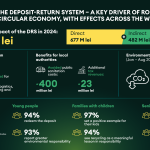
Speeding up change
Foto: BiancoBlue / depositphotos.com
Judging by figures reported by the National Bank of Romania (BNR), the banking industry has dodged a bullet during the COVID pandemic of last year. The profits of the 34 lenders indeed fell more than 17% to RON 5.2 billion, but the total assets climbed 13% to a record breaking RON 560 billion. While smaller actors were more affected, bigger banks fared better – even if more than 700,000 clients asked for a deferment of loan repayments, the rate of non-performing loans reached 3,89% in November, a low point since 2009.
However, the legacy of COVID may very well less quantifiable in bank ledgers. In chemistry, a catalyst is a substance that accelerates a certain reaction. Leave hydrogen peroxide on the counter long enough and it will decompose into water and oxygen. Add some magnesium permanganate, and the reaction will be instantaneous. Not only that, it will be quite a spectacular show.
The same now happens in the banking sector. Put banks and technological advance together, and the result is steady change. Add a pandemic, and the process will be significantly accelerated. For many years already, the leaps made in IT&C changed the way information is processed in banks, which in turn led to a very different handling of client relations.
In Romania’s large cities, until only a few years ago, bank branches were a significant part of the urban landscape. Today, not so much anymore. Even a very short time ago, if and when you needed a credit, or a new card, wanted to make a simple money transfer or exchange Euros to Lei, you had to go to a bank branch. All of this is now done with a phone in a matter of minutes.
I don’t even know where my own bank branch is anymore. I remember having received a letter telling me that my old branch will be closing, and my file will be moved to a new one. But I never bothered to check where, because I didn’t need it. I do my banking on my phone and my cards get send by post.
In January, a study on the digitalization of the banking system, commissioned by the Romanian Association of Banks (ARB), interviewed about 1100 customers and revealed that 43% of financial services’ users pay by plastic, while 27% use internet or mobile banking to pay. Moreover, 14% of customers using their mobile banking apps do this on a daily basis – the smartphone is the device most used to access internet or mobile banking services. Trying to find out how people use their bank cards, the study established a 30 percentage point drop in the share of people using them to get cash from ATMs, compared to what the situation was five years ago.
More than half of the customers interviewed in the course of the study explained that they go to a branch of their bank less than once a month and 32% said they do it once a month. Only 14% go to the bank more often. However, 54% said that the branch is their main gateway to products and services,while 25% mentioned the phone. More than 80% prefer to talk to a bank teller to open an account or get a loan.
A McKinsey study largely confirmed these findings. About one in four Romanian clients will continue to use online banking even after the pandemic, and one in five will use mobile banking solutions, the Financial Insight Pulse survey showed in August 2020.
The pandemic is also likely to have played a role in shifting people’s mindsets from cash to cards. At the end of 2020, the total number of cards issued reached 18,8 million, about 600,000 more than at the end of 2019. There were more POS devices (255,000 compared to 230,000) and fewer cash machines. The number of cash withdrawals from ATMs dropped from 74 million in 2019 to 64 million in 2020, while the number of card payments rose from 216 million to 265 million.
The new frenzy of digital payments is not only driven by banks. The financial market is now open for much more entities, and many new payment services providers are offering their products. Even some Romanian phone companies now issue cards, not to mention the slew of international providers (with Revolut, which started as a fintech provider now morphs into a bank).
New legal regulations also require banks to provide access to more information. For instance, the European Union’s PSD 2 Directive makes it possible for firms offering account management to gain access to bank clients data via so-called open application programming interfaces or API, the name they are more commonly known under.
For bank customers the new digital gimmicks may make life easier, but for the people working in the bank industry, they tell a different story altogether. The more digital everything becomes, and the more people lose their jobs: according to figures reported by the Romanian central bank BNR at the request of Ziarul Financiar, in 2020 more than 180 bank branches and offices were closed and over 450 employees left the system. And the pace of restructuring even slowed down compared to 2019, when 323 branches closed and more than 630 people lost their jobs. Today, less than 53,000 employees work in banking, the number of branches dropped to under 4,000.
And it’s not just that fewer clients interact directly with their branch and therefore fewer employees are needed in the front office to deal with them. Internal bank processes tend to be more automated as well. Machines are taking over classic jobs people used to do, with data mining, artificial intelligence, deep learning, algorithms being only a few of the new buzzwords in the industry.
In a 2018 research quoted by the International Banker publication, McKinsey found that currently demonstrated technologies can “fully automate” 42 percent and “mostly automate” a further 19 percent of finance activities.
The technological revolution has its own set of problems.
Take risk analysis, one of the core activities in banks. To speed up the process of handling loan applications, banks use data and algorithms to predict a customer’s creditworthiness and likely repayment behavior. Based on that, the bank either approves or rejects applications. This process seems more objective than when it’s done by a human risk analyst, but for the person getting rejected it is still painful and they will want to know a reason. But banks are reluctant to disclose the reasons for rejecting credit applications – for obvious reasons, since somebody could try to manipulate the system, but also because the algorithms.themselves are not very transparent.
In some countries, the legislators will not stand for this.
According to the online publication Algorithm Watch, in May 2019 Poland introduced a new provision to the Banking Act, making it mandatory for institutions legally authorized to grant loans to provide a written explanation of their assessment of the applicant’s creditworthiness. So Polish clients now have a legal right to explanation when a bank makes a loan decision. At request, the bank must provide the list of criteria it used. In July 2020, the Polish Financial Supervision Committee UKNF published a report on how banks were complying with the new rules saying that while banks nominally complied with the new rules, in practice they provide general statements without indicating specific and detailed data about the applicants and their financial situation.
So while the new technologies pose advantages to banks in terms of faster automated processes, they also create new challenges on the regulatory front. Transparency for instance is seen as an important tool to fight the problem of AI bias. A landmark study from UC Berkeley demonstrated in 2018 how minority borrowers are overcharged. Lenders use big data variables and machine learning to infer the extent of competition for a specific customer and will then price a loan accordingly. Pricing might be based on geographic specifics, taking into account if an area has fewer financial services. Plus, if an AI can figure out which applicants might do less comparison shopping and accept higher-priced offerings, the bank will resort to what the authors of the study call algorithmic strategic pricing. “There are a number of reasons that ethnic minority groups may shop around less—it could be because they live in financial deserts with less access to a range of products and more monopoly pricing, or it could be that the financial system creates an unfriendly atmosphere for some borrowers,” the study claims. “The lenders may not be specifically targeting minorities in their pricing schemes, but by profiling non-shopping applicants they end up targeting them.”
It is unlikely that such a sophisticated debate will apply to the situation in Romania, but banks are heavily regulated on an international level, and lenders will probably have to comply to what is decided in Brussels, but no only there.
Alex Gröblacher
Share
Share















